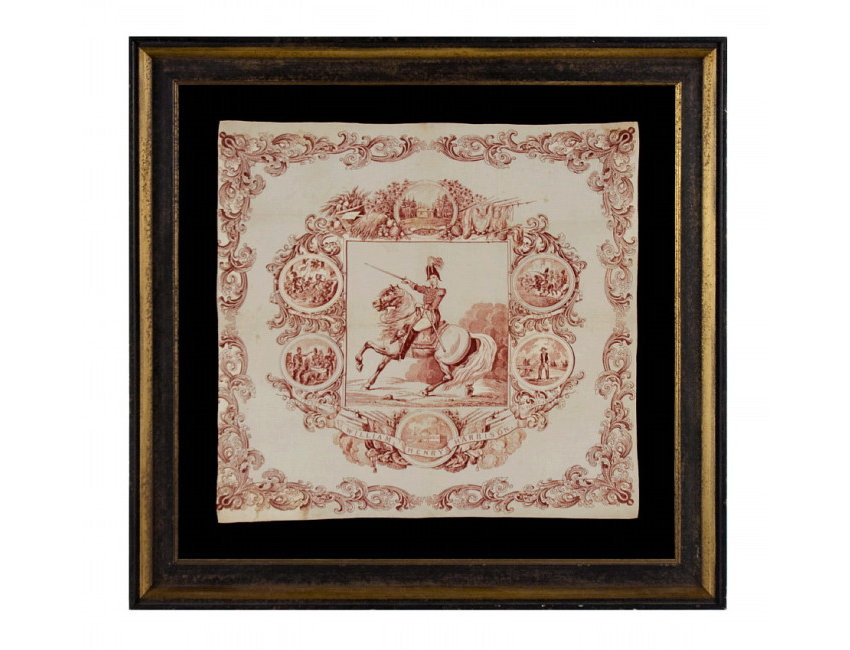|

|
Description: |
|
| Political campaign kerchief, printed on cotton, made for the 1840 presidential run of Whig Party candidate William Henry Harrison. Before 1840, it was considered in poor taste for presidential candidates to campaign for the office. This is why Harrison�s kerchiefs, flags, and banners are among the earliest known to exist. Kerchiefs are known for only two earlier presidents, Andrew Jackson and John Quincy Adams. The Adams example appears to be an inaugural souvenir, because the text that appears in its repeating circular medallions reads �His Excellency; John Quincy Adams� [see Collins, item 66, p. 76]. It is unclear if the Jackson example is celebratory or a campaign piece [see Collins, item 69, p. 77]. So Harrison�s kerchiefs are potentially the first ever distributed to try to get a candidate elected.
Printed in mulberry red ink on white cotton, this kerchief's imagery includes a sweeping portrait of our 9th President, on horseback, in full military garb with sword drawn, prominently featured in a square center window. This is framed by a fanciful wreath comprised of six circular medallions, each of which contains a different landscape. Together they paint a picture of Harrison's achievements. Included are his famous 1811 military victory over Shawnee Indian chief Tecumseh and a confederation of various Indian nations at the Battle of Tippecanoe. Also included is a vignette commemorating the War of 1812 victory over Native American and British forces at the battle of Thames in Canada, considered pivotal in the war and second only to Andrew Jackson's triumph at the battle of New Orleans. There are illustrations of a landmark treaty with Northwest Indian Tribes (one of two he facilitated), and of the United States Capital, where Harrison served as both a U.S. Congressman and Senator.
While Harrison was wealthy and maintained residence in Indiana in an expansive house, part of the home had formerly been a log cabin. Harrison drew upon this humble image, his adopted Ohio residence, and a new profession in farming in order to portray himself as a man of the common people. Included are illustrations of the log cabin and of Harrison posing as "the Ohio Farmer", plowing fields in North Bend. His 20-room, 13-fireplace, Indiana home, called Grouseland, was hardly a cabin in any sense, and became a focal point of life in the expanding west. There he met with Indian tribes, managed his many affairs while governor of the newly named Indiana Territory, that he had helped to create, and invited townspeople to seek refuge in the house during Indian attacks.
William Henry Harrison (b. Feb. 9th, 1773) was the son of wealthy plantation owner Benjamin Harrison V, who was a delegate to the second Continental Congress, a signer of the Declaration of Independence, and Governor of Virginia. William was the last president to be born as a British subject. Following his military career he became secretary of the Northwest Territory, then governor of the subsequently divided Indiana Territory, then moved to Ohio where he served as a U.S. Congressman, State Senator, and U.S. Senator.
Martin Van Buren, Harrison�s Democrat opponent, was a New Yorker and the incumbent president. Van Buren's aristocratic air, combined with economic depression that included the devastating collapse of the Second National Bank of the United States, subsequently lost him the 1840 election.
But things would not go well for the newly elected president. At the age of 68, Harrison was a long-winded speaker. He went to his inauguration without a topcoat and droned on for an hour and forty-five minutes in a snowstorm, before greeting guests and remaining outdoors for a prolonged period. He subsequently caught pneumonia and died just 32 days after taking office. Vice President, John Tyler, was chosen for the ticket because he was a Southerner and thus balanced the interests of slave owners. Tyler finished out his 4-year term but was generally unsuccessful in the White House, unpopular, and did not seek reelection.
Mounting: The kerchief has been hand-stitched to 100% cotton, black in color, which was washed to reduce excess dye. An acid-free agent was added to the wash to further set the dye and the fabric was heat-treated for the same purpose. The mount was then placed in a black-painted, hand-gilded and distressed Italian molding. The glazing is U.V. protective acrylic. |
| Inventory Number: |
|
|
|
Dealer |
Jeff R. Bridgman American Antiques, llc |
| Contact |
Jeff Bridgman |
Phone: (717) 502-1281 |
|
| Period: |
19th Century (1801-1900) |
|
| Date: |
1840 |
|
| Origin: |
|
|
| Condition: |
There are minor stains and foxing, but the condition is extraordinary, especially for the period. |
|
| Measurements: |
Frame: 37" x 38.25" Kerchief: 26" x 27.25" |
|
| Inventory |
Other Inventory by this Dealer |
|
| Web-site: |
http://www.jeffbridgman.com |
|
| Price: |
SOLD |
|
| E-mail: |
Inquire
|
|
Click thumbnail
to view larger
|
